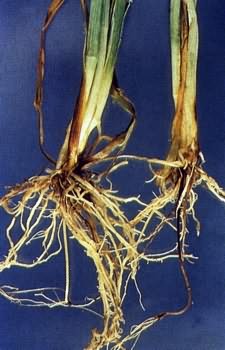Diseases
Fusarium culmorum (W.G. Sm.) Sacc. var. culmorum - Common Root Rot of Barley
Systematic position.
Class Hyphomycetes (Mitosporic fungi), order Moniliales, family Tuberculariaceae, genus Fusarium. The most widespread pathogen of the Common Root Rot of Barley is Fusarium culmorum var. culmorum [synonyms: F. culmorum (W. G. Sm) Sacc. var. cerealis (Cooke) Wollenw., F. discoloriformis Raillo, F. sambucinum Fuckel var. cerealis (Cooke) Raillo]. The Root Rot is also caused by Bipolaris sorokiniana and concomitant species of the genus Fusarium, such as F. graminearum Schwabe. [synonym: F. rostratum Appel and Wollenw., teleomorph: Gibberella zeae (Schwein). Petch. (synonym: G. saubinetii (Mont.) Sacc.], F. oxysporum Schltdl. var. oxysporum (synonyms: F. bulbigenum Cooke et Massee, F. tracheiphilum E.F.Sm, F. lini Bolley, F. orthoceras Appel et Wollenw., F. conglutinans Wollenw., F. angustum Sherb., F. bostrycoides Wollenw. et Reinking), F. avenaceum (Fr.) Sacc. var. avenaceum (synonym: Fusisporium avenaceum).Biological group.
Hemibiotrophic parasite attacking species of genera Triticum, Hordeum, Secale, Avena, Zea etc. from the family Poaceae.Morphology and biology.
Infected tissues of crown, leaf, and culm can turn brown to pinkish-red. The subcrown internode and the culm part 3 to 10 cm long above the soil can be darkened or brown. Sometimes it is impossible to distinguish the symptoms caused by Bipolaris sorokiniana from those caused by F. culmorum without laboratory analysis. Sometimes, there are no visible symptoms of the infection, and it can be only detected in pulling plants by examining the crown and subcrown internode. Severely infected plants can ripen prematurely and develop a bleached white appearance. Fusarium species are easily isolated from plant tissue, debris, and soil. Important characters for the Fusarium species identification are the shape of macroconidia, the presence or absence of microconidia, and colony morphology and color on potato-dextrose agar made of fresh ingredients. F. culmorum produces extensive mycelium, not producing microconidia in culture, but macroconidia are abundant. The macroconidia are three (18.0-44.0 x 3.7-8.5 mkm) to five-septate (23.0-74.0 x 4.0-9.0 mkm), slightly curved, with a pointed apex and well-marked foot cell. Oval to globose chlamydospores (10-14 x 9-12 mkm) develop singly, in chains, or in clumps within mycelium or macroconidia. Inoculum occurs freely in soil and in host debris and seeds of wheat and barley. F. culmorum survives as chlamydospores, conidia, and mycelia in soil. Conidia germinate in the presence of susceptible hosts and initiate the primary infection on coleoptile or primary roots.Distribution.
The disease is widely distributed throughout the world. In CIS countries it meets everywhere in areas of barley cultivation.Ecology.
Most of conidia are found in the top 15 cm layer of soil. Environmental factors affect greatly the severity of the Common Root Rot. Warm soil at temperatures 20-30oC favors the fungus growth. Losses are probably the most severe in years of lowered humidification, when plants are stressed for water, or in years with extreme temperatures. Sporulation is optimal at a water potential of about .1.5 maximum permissible amount (MPA). Germination of conidia or chlamydospores is maximal at .0.1 to .2 MPA.Economic significance.
F. culmorum and F. graminearum are most important in North-West and Central regions of Non-Chernozem Zone, in Central Chernozem, North Caucasian, North Volga regions, in Western and Eastern Siberia. In these regions the disease severity can reach 50-60% under favorable conditions. The yield losses can reach to 50-60% at the disease severity 28-35%. In northwestern Ukraine, average yield losses are estimated as 20%. Damage is significant when the disease severity is equal to or more than 20%.Related references:
Buga S.F., Lukashik N.N. 1982. Role of fungi of the genus Fusarium and Helminthosporium sativum P. K. et B. in pathogenesis of barley common root rot in BSSR. In: Editor. Collection of scientific works of Byelorussian Research Institute of Plant Protection. Plant protection. V.7. Minsk: Urozhai: 66-74 (In Russian).Chulkina V.A. 1970. Barley root rot in Altai Mountains. In: Peresypkin V.F., ed. Root rots of cereals and its control. Moscow: Kolos, p. 109-117 (In Russian).
Chulkina V.A. 1975. News in root rot researches in Siberia. Vestnik sel.skokhozyaistvennoi nauki 5: 63-69 (In Russian).
Dubinina L.A., Nyamtsu I.A. 1990. Root rot diseases of barley in southern regions of Ukraine. In: Editor. Proceedings of VSGI. Problems of cereals and sunflower resistance to diseases and pests improving. Odessa: VSGI: 65-69 (In Russian).
Filippova T.N., Vlasov D.Yu., Filippova L.I. 1991. Root rot diseases of spring barley in Rostov Region. In: Editor. Proceedings. Problems of Crop Protection from Harmful Organisms in Intensive Agriculture. Leningrad: Publisher, p. 69-76 (In Russian).
Ishkova, T.I., Berestetskaya, L.I., Gasich, E.L., Levitin, M.M., & Vlasov, D.Yu. 2000. Diagnostic of the main diseases of cereals. Saint-Petersburg: VIZR, 76 p. (in Russian).
Khasanov B.A., Vypritskaya A.A., Glukhova L.A. 1990. Barley diseases in North Kazakhstan. Vestnik sel.skokhozyaistvennoi nauki Kazakhstana (Alma-Ata) 10: 32-36 (In Russian).
Korshunova A.F. 1970. Root rots of winter wheat and winter barley near North Caucasus. In: Peresypkin V.F., ed. Root rots of cereals and its control. Moscow: Kolos, p. 46-49 (in Russian).
Molodykh L.V., Rochev M.V. 1984. Species composition of causal agents of barley root rot in Sverdlovsk Region. In: Editor. Proceedings. Actual problems of decision of the food program in Middle Ural. Sverdlovsk: Publisher, p. 56-57(In Russian).
Sidorov A.A. 1988. Root rot diseases of barley and cultivars resistance in Central regions of Non-Chernozem Zone of RSFSR. PhD Thesis. Bolshie Vyazemy: VNIIF, 21 p. (In Russian).
Surin N.A., Sorokataya E.I., Gromovykh T.I., Zobova N.V. 2001. Necessity of improving spring barley resistance to common root rot in Krasnoyarsk Territory. Reports of Russian Academy of Agricultural Sciences 3: 16-18 (In Russian).
Yushko P.A., Yudkin L.U., Reiter B.G., Yudkina N.B. 1986. Root rots of barley. Zashchita rastenii 11: 28 (In Russian).
Mathre, D.E., ed. 1997. Compendium of barley diseases. APS PRESS. 90 p.


